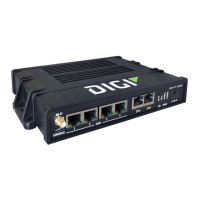Virtual Private Networks (VPN) Generic Routing Encapsulation (GRE)
Digi Connect EZ Mini User Guide
280
8. If GREis selected for the Mode, for Remote endpoint, type the IP address of the GRE endpoint
on the remote peer.
9. (Optional) For Key, enter a key that will be inserted in GRE packets created by this tunnel. It
must match the key set by the remote endpoint. Allowed value is an interger between 0 and
4294967295, or an IP address.
10. (Optional) Enable keepalive reply to enable the device to reply to Cisco GREkeepalive
packets.
11. (Optional) Enable open routing to enable packets destined for an address which is not
explicitly in the routing table to exit the IP tunnel.
12. Click Apply to save the configuration and apply the change.
Command line
1. Select the device in Remote Manager and click Actions > Open Console, or log into the
Connect EZ local command line as a user with full Admin access rights.
Depending on your device configuration, you may be presented with an Access selection
menu. Type admin to access the Admin CLI.
2. At the command line, type config to enter configuration mode:
> config
(config)>
3. Add the GRE endpoint tunnel. For example, to add a tunnel named gre_example:
(config)> add vpn iptunnel gre_example
(config vpn iptunnel gre_example)>
GRE tunnels are enabled by default. To disable:
(config vpn iptunnel gre_example)> enable false
(config vpn iptunnel gre_example)>
4. Set the mode:
(config vpn iptunnel gre_example)> type value
(config vpn iptunnel gre_example)>
where value is either:
n gre: Standard GRE point-to-point protocol.
n mgre: multipoint GREprotocol.
5. Set the local endpoint to the GREendpoint interface created in Task One, for example:
(config vpn iptunnel gre_example)> local /network/interface/gre_endpoint
(config vpn iptunnel gre_example)>
6. If type is set to gre, set the IP address of the GRE endpoint on the remote peer:
(config vpn iptunnel gre_example)> remote ip_address
(config vpn iptunnel gre_example)>

